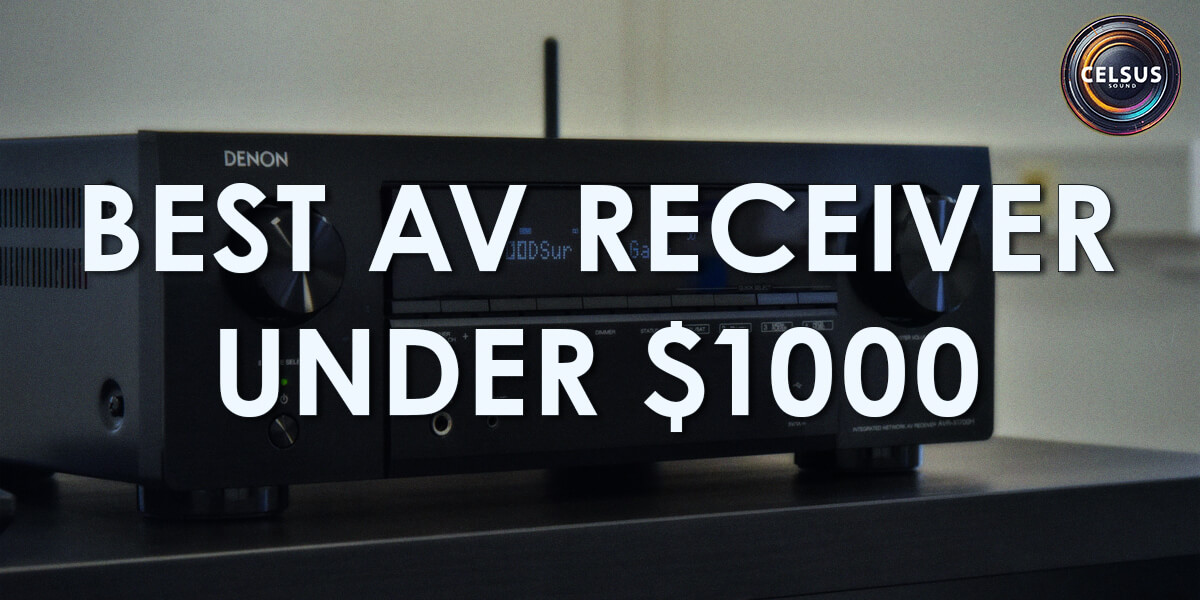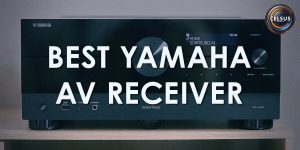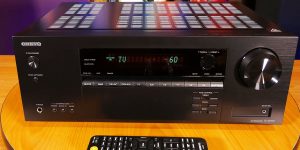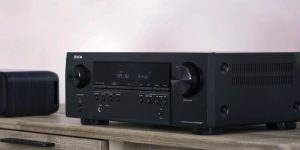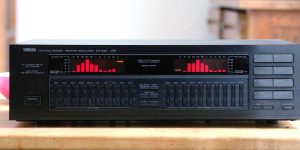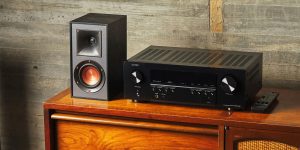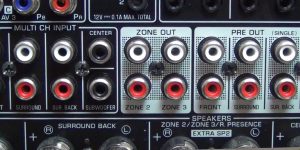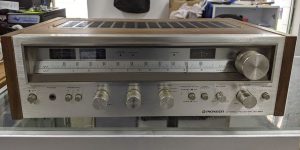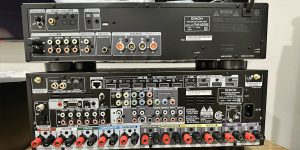Have you decided to replace your old receiver with a newer model, or are you just planning your first purchase of such a device? Of course, you hope to spend not too much money and still get excellent results. That’s why today, let’s talk about the average price range. I decided not to focus on only one brand and selected the best receivers under 1000 dollars from different manufacturers. I think it will be much more helpful for you to compare models of the same class from different brands and then choose the one that will satisfy you the most.
Before we move on to reviews of AVRs, I would like to say a few words about what you can expect when buying a device of this level. I think this is important because many of my readers will realize at the beginning of the article whether they are moving in the right direction or need more functional (or simpler) models.
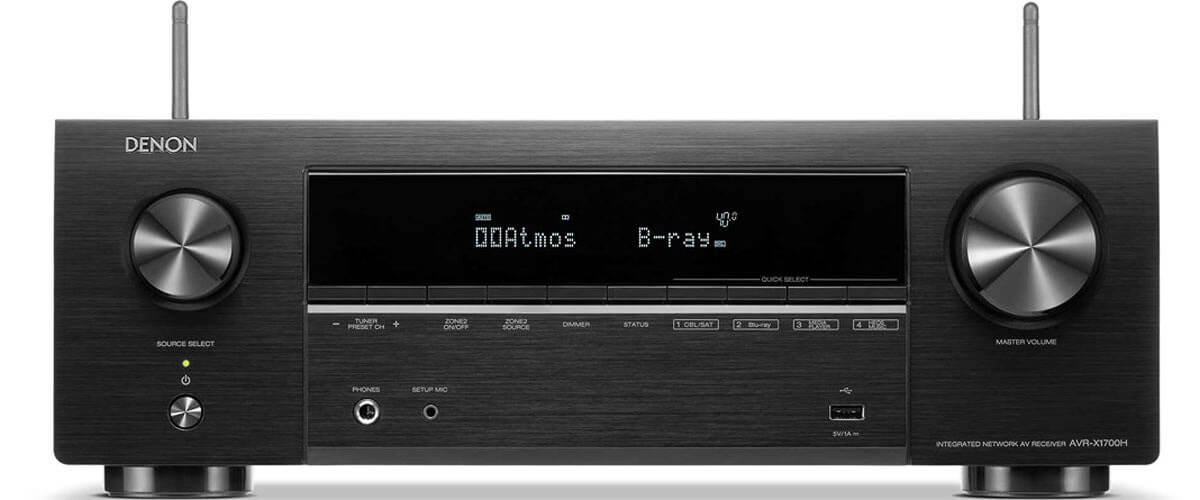
AV receiver under $1000 comparison table
| Name | Channels | Power output | HDMI in/out | Bluetooth/Wi-Fi | Review |
|---|---|---|---|---|---|
| Denon AVR-X1700H best overall | 7.2 | 80W/8 Ohm, 120W/6 Ohm | 6/1 | yes/yes | Review |
| Yamaha RX-A2A also a great choice | 7.2 | 100W/8 Ohm | 7/1 | yes/yes | Review |
| Denon DRA-800H stereo | 2.2 | 100W/8 Ohm, 120W/6 Ohm | 5/1 | yes/yes | Review |
What to expect from home theater receivers under $1000?
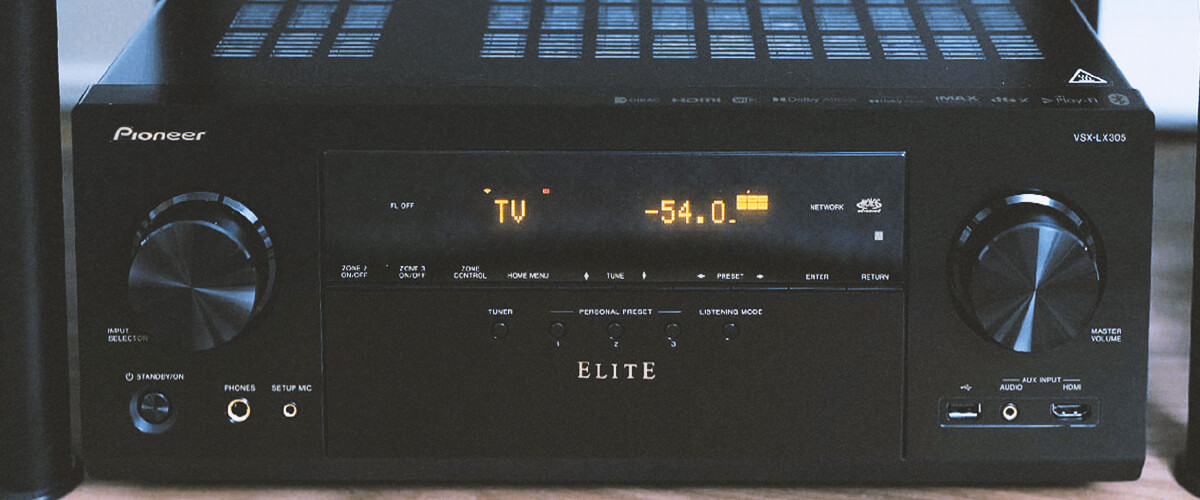
Now, there are many receivers for every taste and color on the market. And sometimes, it can be a little hard to make sense of it all. So, let’s take a closer look at what the devices offer under $1000.
First, you must understand that, unlike budget models, most receivers in this price category are already 7-channel. If you need even more channels (for example, 9), you have to pay more. A good option is the Pioneer Elite VSX-LX305 9.2-channel unit, which I have also included in my list.
Second, mid-range receivers generally offer more HDMI ports and pre and line channels than their budget counterparts. Available video technology should also please you. As a rule, you can find not only 4K resolution but also 8K with eARC support for transmitting a full-resolution signal without losing quality.
Also, top AV receivers under $1000 can offer Dolby Atmos and DTS:X. They allow you to discover three-dimensional sounds which budget devices can’t deliver. As for the newer surround sound technologies, such as DTS:X Pro and Auro-3D, they are very rare among this class of models.
Separately, I would like to dwell on the sound. I will not claim that all models in this price category can be considered AV receivers for audiophiles. However, due to the use of higher-quality components and technologies, such models will sound better than their cheaper counterparts. And the difference between an AV system of this level and a budget device will be quite noticeable.
Network capabilities are the most important aspect of any device today, whether it is a TV, soundbar, or receiver for gaming. We live in a modern world and use a lot of gadgets, as well as turn to the internet to search for different content: music, movies, radio, etc. That is why receivers from this group most often have advanced networking capabilities.
In general, receivers under $1,000 will meet most people’s needs. They completely cover the needs of beginning audiophiles and film fans, supporting most modern audio and video formats. In addition, many devices have various useful and interesting additional features.
By the way, if you already have a receiver (budget or outdated model) and you are not sure whether to upgrade it, I advise you to read the article on this topic. You will immediately become much clearer on how to proceed in this situation.
Best AV receiver under $1000 reviews
Denon AVR-X1700H – best overall

Ever since I was a kid, I’ve loved not putting off the coolest things. That’s why I’m starting my review with the best home theater receiver under $1000. Meet the AVR-X1700H, released by Denon in 2021, which is the most affordable model in the X series. As a reminder (or for those who didn’t know), the X-Series supports all of the most common 3D audio formats, bringing you the ultimate surround sound.
So, what does the Denon X1700H offer us? The 7.2 channel unit has an amplifier with 80 watts per channel (8 ohms, 20 Hz – 20 kHz, 0.08% THD, and 2ch drive). It’s not “buffalo power,” but more than enough for small to medium-sized rooms. It also features discrete high-current amplifiers with low-impedance drive capability. Its 32-bit D/A converters allow high-resolution audio decoding, providing low distortion.
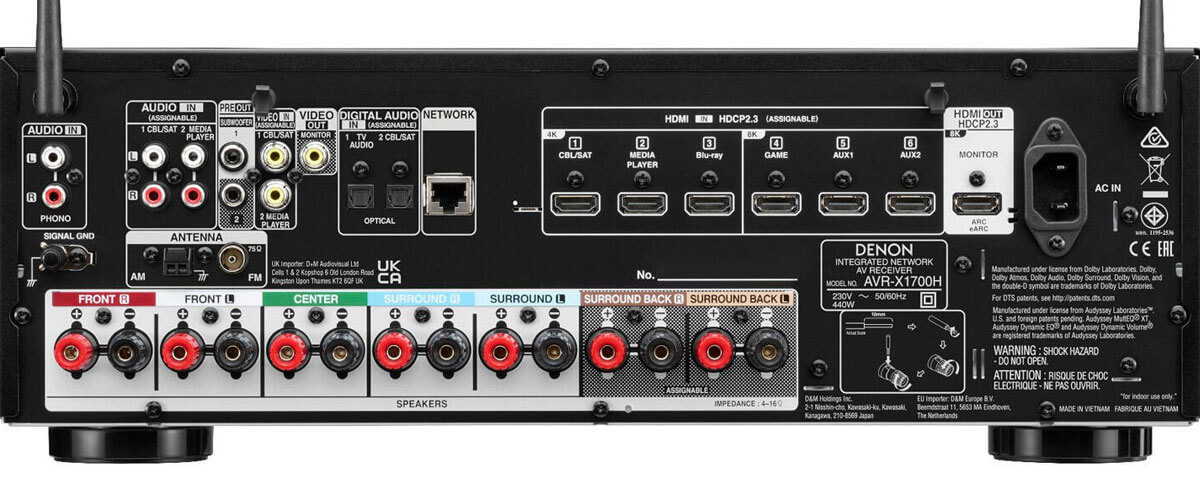
Pictures in 8K/60Hz resolution will appeal to large screen owners. This model offers quite a lot of modern technology for comfortable and high-quality movie viewing. The image looks vivid, clear, and dynamic, thanks to the latest HDR support. And technologies such as QMS, VRR, ALLM, and QFT will please the owners of game consoles. Now shooters will be without lags and no more of your cries of “What’s with the lags?”.
The AVR-X1700H has 6 HDMI inputs (2.1), three of which support 8K resolution and 1 HDMI output with HDCP 2.3 and eARC support. Interestingly, the model uses an updated version of the HDMI 2.1 chip, which provides up to 40 Gbps of throughput. As for connection methods, at your disposal, there are two subwoofer outputs, Ethernet ports, Wi-Fi, and Bluetooth, which allows you to stream music wirelessly.
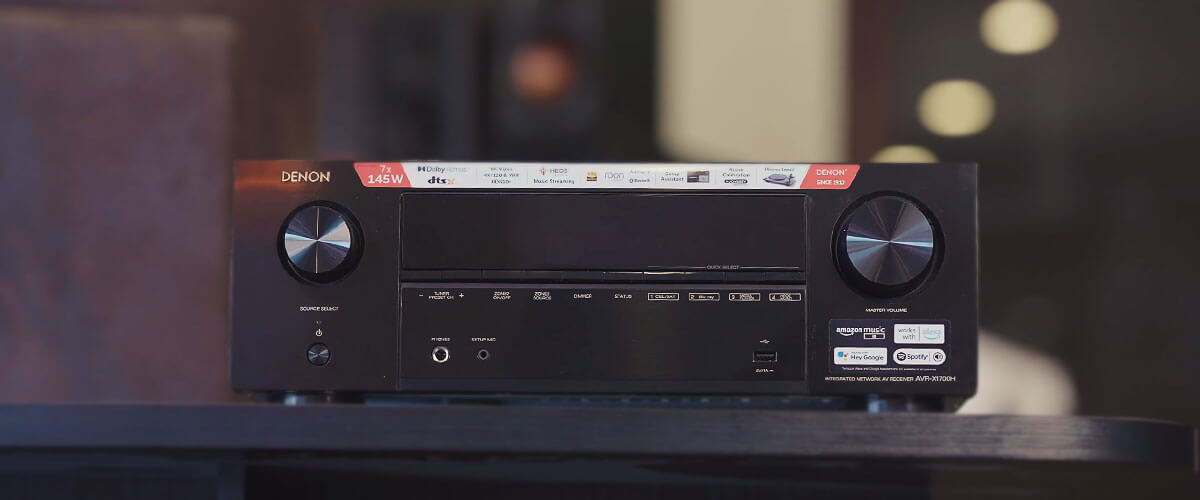
Separately, I want to talk about the sound itself.This model supports Dolby Atmos, DTS:X, Dolby Atmos Height Virtualization, and DTS Virtual:X. While watching the films, I liked that the receiver can boast an excellent deep frontal soundstage, and its sound effects had fairly accurate panning. In addition, it also has two multi-room zones and support for multiple streaming services. Sound calibration is done through Audyssey MultEQ XT, which allows you to fine-tune the sound you want. But keep in mind the app has a one-time fee.
As for the music, it may not compare to a specialized 2-channel stereo receiver under $1000, but it doesn’t have to. If we try to characterize the sound in more detail, I believe there is more velvety euphony here. The scale is wider, but the sound details are as if passed through a special “softening filter.” For modern music, this is rather a plus. But it is still a minus for classical music, where all details are important.
Unfortunately, the device does not come with a detailed manual, so you will likely spend some time on the Denon website learning how to properly set up and use the receiver.
As I said at the beginning of the review, I believe this is the best AV receiver under $1000. And I will once again (for those who still have doubts or haven’t read my review) explain why.
First of all, it has an optimal price/quality ratio. Secondly, it is universal. Fans of movies and modern game consoles will be delighted with it, just like music lovers. Yes, a sophisticated music fan may not be impressed, but I am not suggesting such a person buy this model.
Key specs
- Channels: 7.2.
- Power output: 80W/8 Ohm, 120W/6 Ohm.
- HDMI inputs/outputs: 6/1.
- Video functions: 8K/60Hz, 4K/60Hz, 4K/120Hz, HDMI upscaling up to 8K.
- Bluetooth/Wi-Fi: yes/yes.
- Streaming services: AirPlay 2, Spotify, TuneIn, Deezer, Tidal, Netflix, Amazon Prime.
- Supports: HDMI ARC, HDMI eARC, HDMI CEC, HDCP2.3, HDR10+, Dolby Vision.
- Surround sound: DTS HD Master, DTS:X, DTS Neural:X, DTS Virtual:X, Dolby Atmos, Dolby TrueHD, Dolby Height Virtualization, Dolby Surround.
Pros
- Advanced 8K resolution.
- Supports latest HDR formats.
- Gaming oriented receiver.
- Supports the most popular 3D sound formats.
- 2 multi-room zones are present.
Cons
- Audyssey application has a one-time fee.
- No detailed instructions.
Yamaha RX-A2A – also a great choice
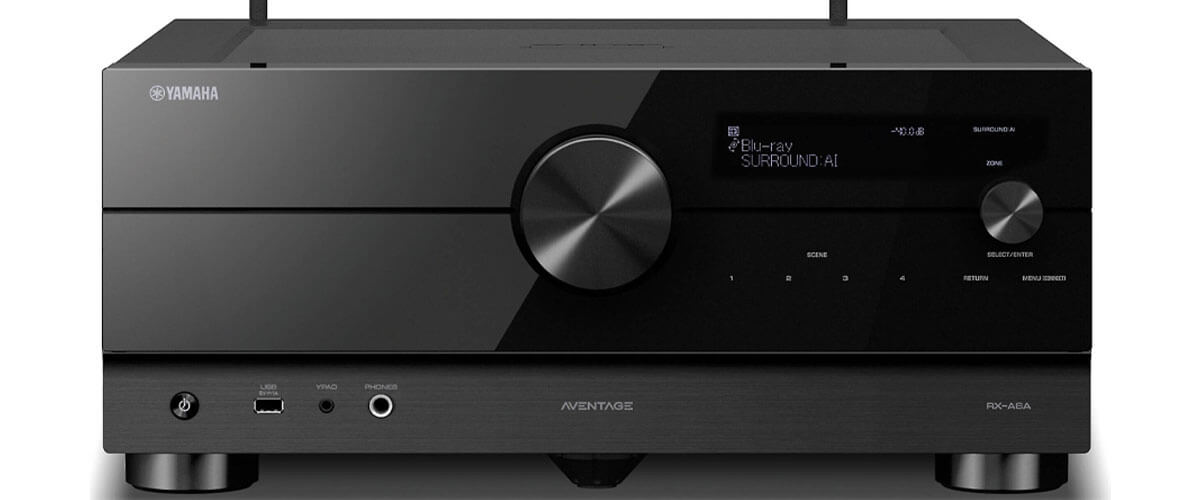
The Yamaha RX-A2A is the most expensive device in my selection, but it is here for a reason. It was released by a Japanese company in 2020, ushering in the RX-A series. A year later, this model was replaced by the RX-A4A. What is remarkable about this rather expensive receiver?
This model is equipped with a 7.2 channel amplifier with a total power of 100 watts (8 ohms, 20 Hz – 20 kHz, 0.06% THD). As you can see, it is more powerful than my winner, and even its THD is better. It’s also important to consider that Yamaha only supports pre-amp out for the left and right front channels.
If we talk about the picture, it looks clear, moderately contrasty, and has good detail of individual elements. The device supports 8K/60Hz and 4K/120Hz, HDR10+, as well as gaming features (ALLM, VRR, QMS, and QFT). In this case, according to user feedback, there is sometimes a problem with unstable signal transmission and, consequently, interruption of the picture. But, during the model testing, I did not notice this; therefore, I can not consider it a weakness of the model. There is also parity between the X1700H and RX-A2A in terms of video capabilities.
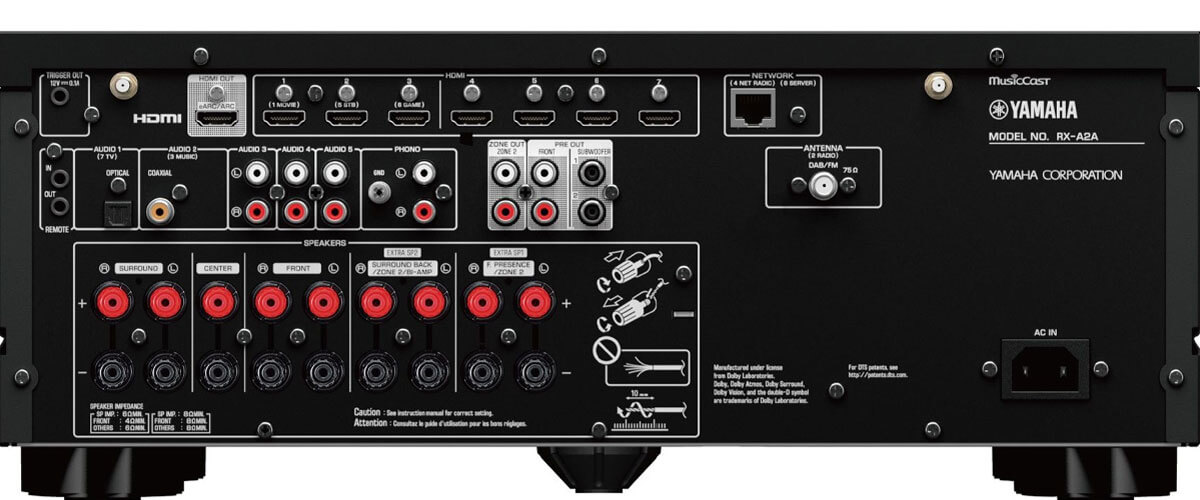
You can calibrate the sound thanks to an exclusive YPAO development. Once the speakers are connected, it measures the distance between the home theater speakers and the listener position and then automatically optimizes the speaker settings according to the parameters of your room. Tuning is easy enough and accurate.
The receiver has 7/1 HDMI ports (2.1) with HDCP 2.3 and eARC support. Among the available connection methods, you can find two subwoofer outputs, Wi-Fi, Bluetooth, USB inputs, and network ports. Is it enough for the home network? Absolutely!
Those who have purchased this Yamaha AV receiver get a typical 7.2 channel sound setup, or in the case of Dolby Atmos – 5.2.2 channels support. Thus, modern surround sound formats and older formats (for example, DTS HD Master and Dolby TrueHD) are available to you.
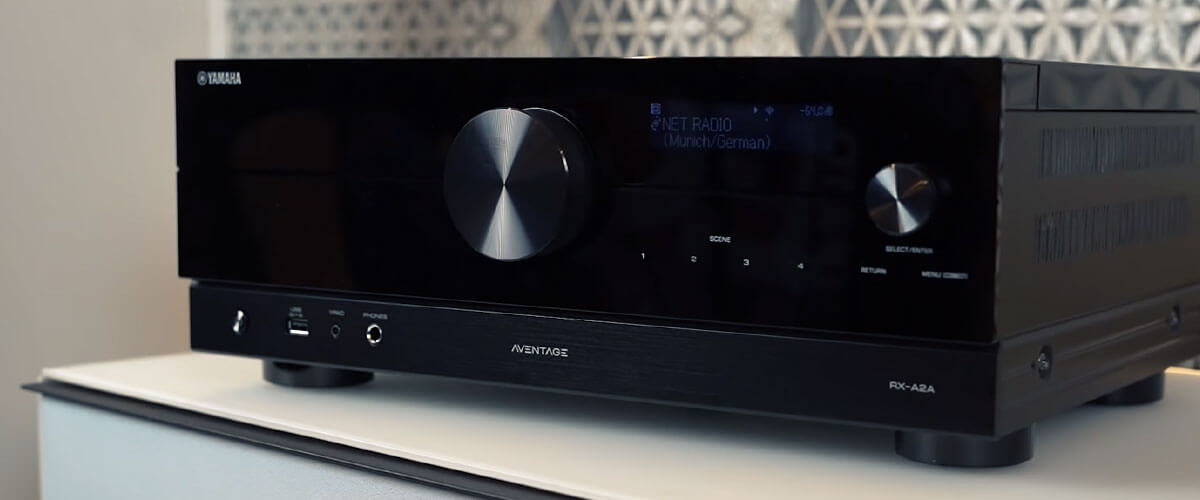
Two multi-room zones are also among the valuable features. I would also like to mention the presence of Yamaha Cinema DSP 3D. This is a sound environment technology developed by Yamaha. It allows you to recreate the acoustics of concert halls and music clubs. Doesn’t it sound interesting and intriguing? After listening to a few songs using this technology, the sound seemed artificial and overly processed. I can’t say that I was disappointed, but I was definitely expecting more. That’s why I think that this AV receiver for music won’t be the optimal option.
Sometimes you may notice that the software lags and some applications freeze, as in my case with HBO Max. However, after a quick AVR restart, everything started working perfectly again.
I think you have already realized that this is a great AVR under 1000 dollars. Yes, it is a bit more expensive than my winner, but in some aspects, it beats it in functionality. So, I’m already anticipating your difficulties when choosing between RX-A2A and AVR-X1700H. But whatever your choice will be, you won’t be disappointed.
Key specs
- Channels: 7.2.
- Power output: 100W/8 Ohm.
- HDMI inputs/outputs: 7/1.
- Video functions: 8K/60Hz, 4K/60Hz, 4K/120Hz, HDMI upscaling up to 4K.
- Bluetooth/Wi-Fi: yes/yes.
- Streaming services: AirPlay 2, Spotify, TuneIn, Deezer, Tidal, Netflix, Amazon Prime.
- Supports: HDMI ARC, HDMI eARC, HDMI CEC, HDCP2.3, HDR10+, Dolby Vision.
- Surround sound: DTS HD Master, DTS:X, Dolby Atmos, Dolby Atmos Height Virtualization, Dolby TrueHD, Dolby Digital Plus, Dolby Surround.
Pros
- The lowest THD in my review.
- The highest number of HDMI ports (7) among other analogs in my article.
- CINEMA DSP 3D is available.
- Amplifier with high slew rate.
- Easy setup thanks to YPAO.
Cons
- The software sometimes lags.
- No HDMI port on the front panel.
- The front display of the receiver is hard to read.
Marantz NR1510
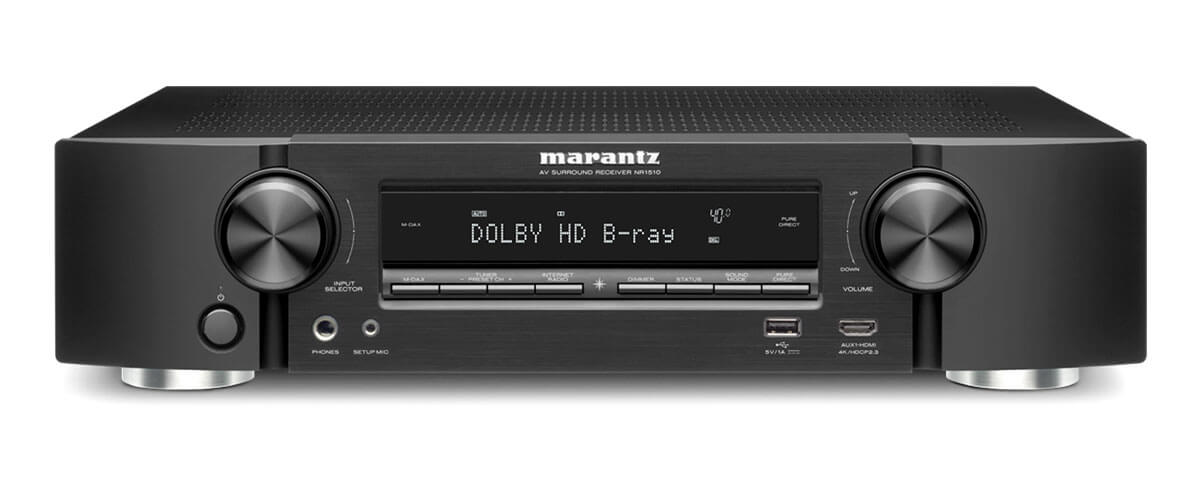
The Marantz NR1510 is number three on my list. This device was released in 2019. The Marantz AV receiver belongs to the NR line, where it stands next to a 7.2-channel receiver NR1711 and a 2-channel stereo model NR1200.
The NR1510 is a 5.2-channel unit with about 50 watts per channel (8 ohms, 20 Hz – 20 kHz, THD: 0.08%). One of the main advantages is its compact and slim design. The front of the panel has two big rotary knobs on each side for volume and input selection. There is also a small central display with a slightly outdated user interface. The model legs are made of metal. Overall, it looks pretty stylish and minimalistic.
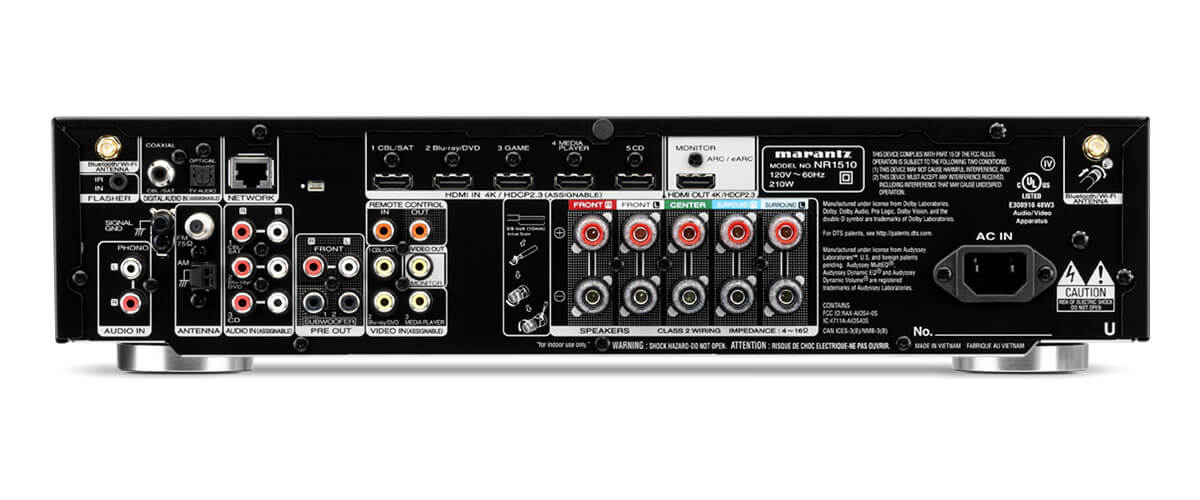
As for the picture, it supports 4K Ultra HD at 60 Hz. I tested it on a 65-inch TV and was pleased with the result. Everything looks quite clear and bright. By the way, although you can find a lot of information on the Internet about the problem of connecting the receiver to the TV through an HDMI cable, in my case, everything went smoothly.
But I had time to face a completely different situation, namely the periodical disconnection from the network. I had to reboot the receiver for the model to recognize Airplay. I don’t know if I’m the only “lucky” one or if someone else had this situation too, but I didn’t like it very much. In addition, even though the device channels are designed for 4-16 ohms impedance, I cannot recommend you connect the complete set of 4-ohm speakers to this model. You have to be careful even with a single pair of 4-ohm speakers.
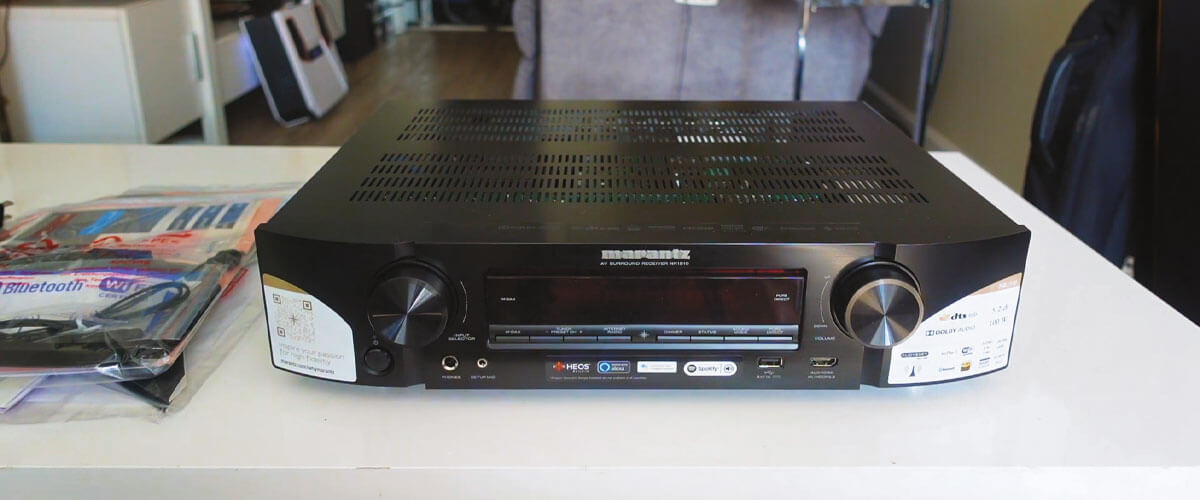
The Marantz has six HDMI inputs (2.0) and one HDMI output (2.0) with HDCP 2.3 and ARC support. You can connect to the model due to 2 subwoofer outputs, Bluetooth, Ethernet Ports, Wi-Fi, and Phono (MM) In.
Unfortunately, this receiver cannot boast an exciting surround sound because there is no DTS:X and Dolby Atmos.
The Marantz NR1510 is a receiver with a rich set of inputs and functions which remains as slim and compact as possible. It’s great for small rooms and undemanding use. But if this is not your case, then I would consider other options.
Key specs
- Channels: 5.2.
- Power output: 50W/8 Ohm,60W/6 Ohm.
- HDMI inputs/outputs: 6/1.
- Video functions: 4K/60Hz.
- Bluetooth/Wi-Fi: yes/yes.
- Streaming services: AirPlay 2, Pandora, Spotify, Napster, SiriusXM, TIDAL, Deezer, Qobuz, Amazon Music.
- Suppots: HDMI eARC, Dolby Vision, HDR 10.
- Surround sound: Dolby Atmos, Dolby Atmos Height Virtualization, Dolby TrueHD, Dolby Surround, Multichannel Stereo.
Pros
- 4K Ultra HD.
- Slim design.
- HEOS technology is available.
- Supports Hi-Res audio.
- Phono (MM) input is present.
Cons
- No Dolby Atmos and DTS:X.
- HDMI version 2.0.
- Trouble connecting to the network.
Pioneer Elite VSX-LX105
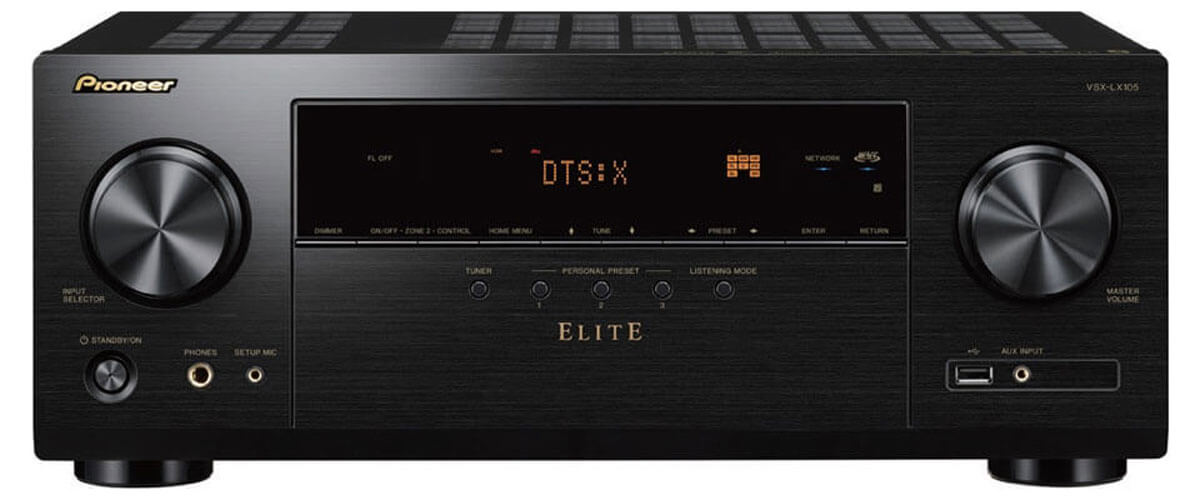
The penultimate model that deserves your attention is the Pioneer Elite VSX-LX105. It was introduced at CES 2021 as the most affordable device in the VSX-LX series (US market only). Its older brother is VSX-LX305.
The receiver is equipped with a 7.2-channel amplifier with about 100 watts per channel (8 ohms, 20 Hz-20 kHz, THD 0.08%). With this model, you don’t have to worry about coming across a defective device because the VSX-LX105 has been profiled as Roon-Tested. Thus, you will definitely receive a quality and certified product.
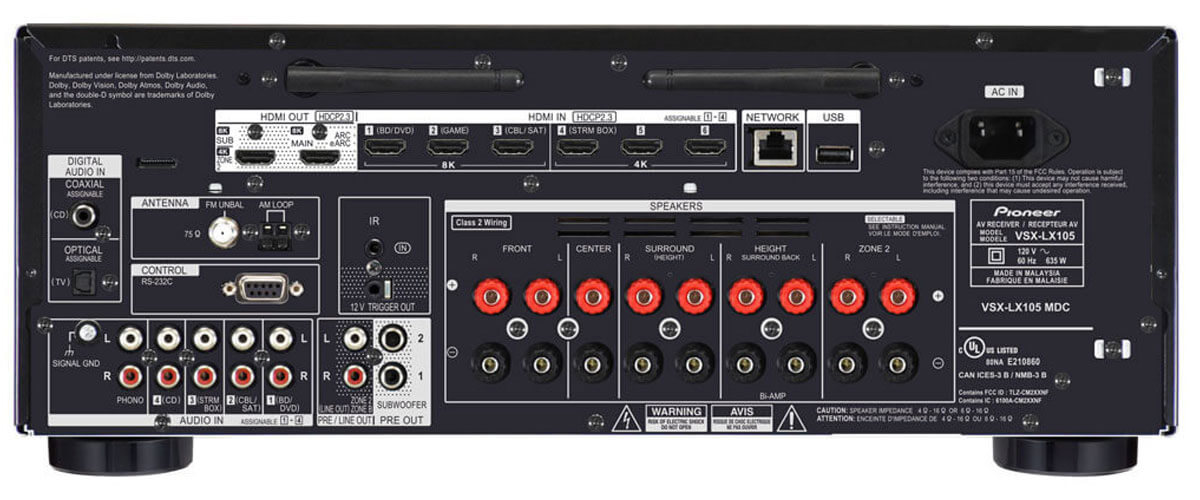
As for the video reproduction capabilities of the Pioneer, it supports a picture in 8K resolution at 60Hz, as well as all modern technologies such as Dolby Vision, HDR10+, and others. As a result, the images have incredible clarity and contrast and can be viewed from different angles.
Also, here you will find two multi-room zones. But it is essential to consider that only Zone 1 supports 8K pass-through.
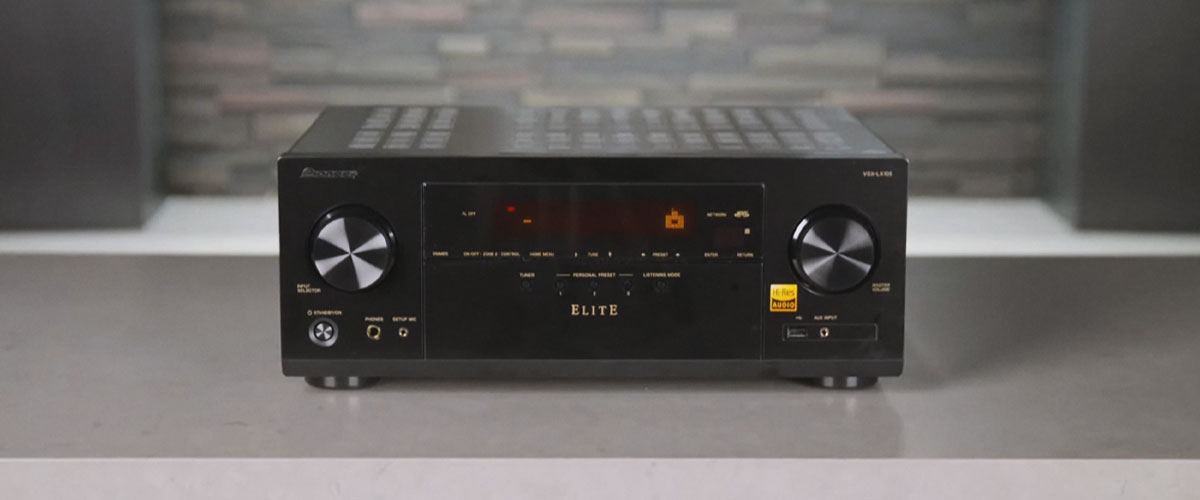
In terms of connectors and connection methods, the receiver has 6 HDMI inputs (2.1) and 2 HDMI outputs (2.1) with support for HDCP 2.3 and eARC. Available connectivity options include 2 subwoofer outputs, standard Ethernet, dual-band Wi-Fi, and Bluetooth. You’ll also find DTS Play-Fi, Flare Connect, and AirPlay2.
The Pioneer Elite VSX-LX105 is a surround sound receiver because it is equipped with technologies such as Dolby Atmos and DTS:X in 5.2.2 configurations. After simply calibrating the unit with the MCACC automatic room tuning technology, the sound playback was at a very good level. While watching the film, I could feel myself in the middle of the events. Everything that was happening had a nice soundstage with breathtaking depth.
The VSX-LX105 will accompany you for years to come. Thanks to its multi-channel and network audio capabilities, it is an excellent receiver with sufficient power even for large rooms. In addition, the device is easy to use, multifunctional, integrated into smart home automation, and supports modern home theater video and audio technologies.
Key specs
- Channels: 7.2.
- Power output: 100W/8 Ohm, 210W/6 Ohm.
- HDMI inputs/outputs: 6/2.
- Video functions: 8K/60Hz, 4K/60Hz, 4K/120Hz, HDMI upscaling up to 8K.
- Bluetooth/Wi-Fi: yes/yes.
- Streaming services: AirPlay 2, Spotify, TuneIn, Deezer, Tidal, Netflix, Amazon Prime.
- Supports: HDCP2.1, HLG, HDR10+, Dolby Vision.
- Surround sound: DTS HD Master, DTS:X, DTS Neural:X, DTS Virtual:X, Dolby Atmos, Dolby TrueHD, Dolby Atmos Height Virtualizer, Dolby Digital Plus.
Pros
- 8K pass-through.
- Dolby Atmos and DTS:X technologies are present.
- Discrete zone 2 HDMI switching.
- The receiver profiled as Roon-Tested.
- There are 2 HDMI outputs.
Cons
- Sometimes the model can overheat.
- No front-wide channel support.
Denon DRA-800H – stereo
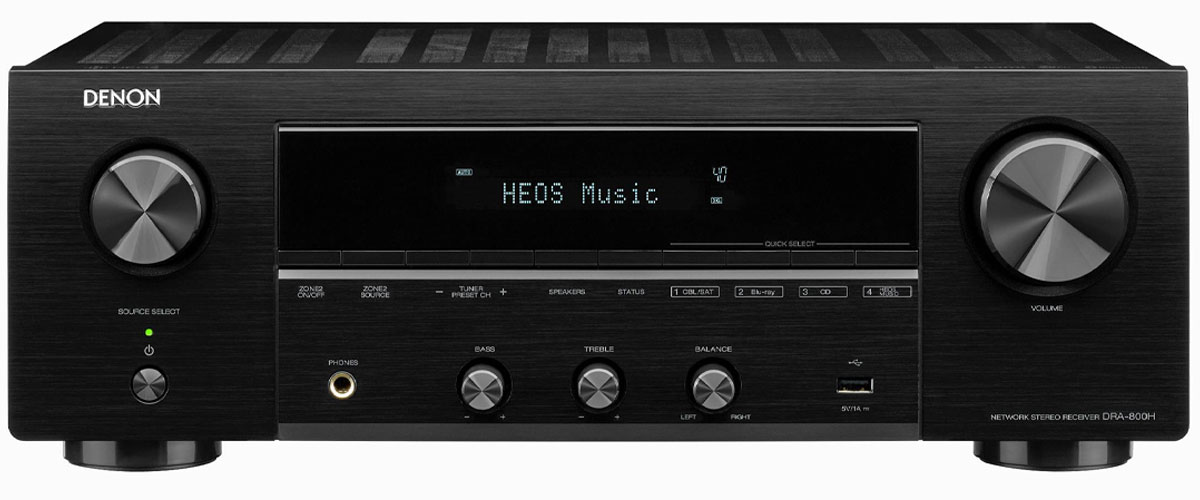
Receivers are always about sound. And the sound is not only explosions in cool action movies or shots in Call of Duty. It’s music, songs… So why can’t I add to my review a model that differs from the usual AV receivers and is a stereo receiver? I can, and I will! Especially because I like it very much. But I’m getting a bit ahead of myself.
Denon released this device in 2019, which is still relevant today. In addition, it is such a successful model that it can challenge even AV receivers.
The receiver has a 2.2-channel amplifier with 100W per channel (8 ohms, 20 Hz – 20 kHz, 0.08% 2ch Drive). It is equipped with the advanced AKM AK4458 DAC, allowing you to extend the dynamic range and reduce noise.
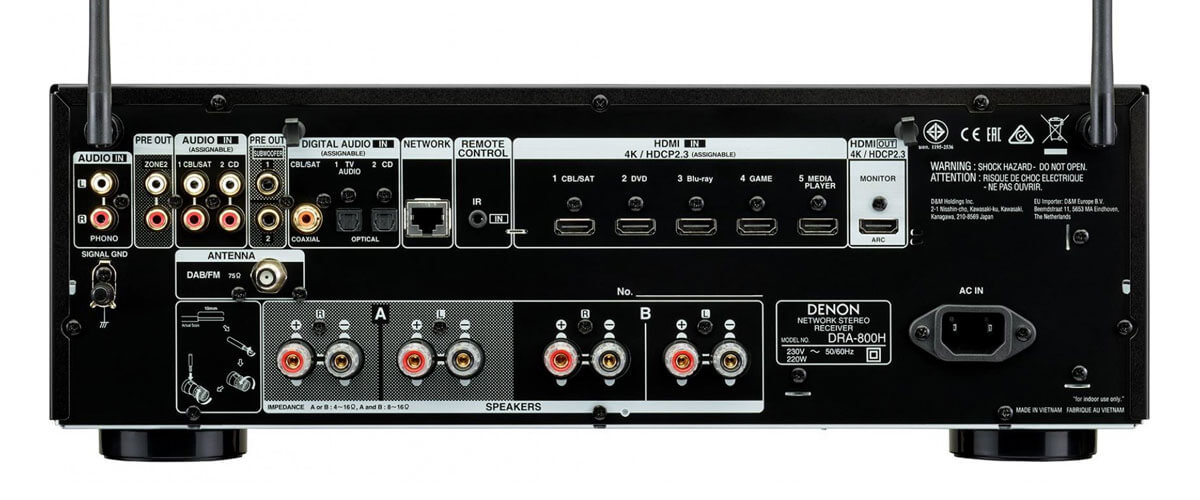
Although the DRA-800H is more than anyone else focused on music, it gives quite a good quality video. The picture in 4K resolution looks clear and detailed on HD and 4K source devices with different screen sizes. Among the supported technologies are the standard HDR10 and Dolby Vision. Even ALLM pass-through for gaming is also present.
Now, let’s talk about formats. The receiver is Hi-Res Audio certified for FLAC, WAV, and ALAC files at up to 192 kHz/24-bit and DSD at 2.8 or 5.6 MHz. By the way, note that AIFF files are not recognized, which will cause parts of your high-resolution library to stop playing, as it did in my case.
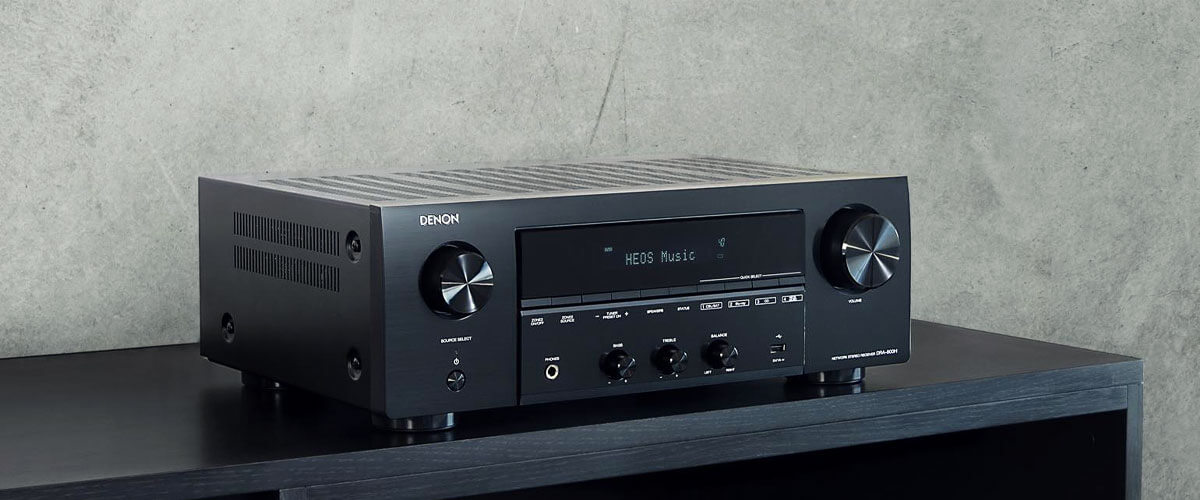
The model has 5 HDMI inputs (2.0) and 1 HDMI output (2.0) with ARC/HDCP 2.3 support. Available connectivity options include 2 subwoofer outputs, Bluetooth, Ethernet Ports, and Wi-Fi. But it is worth noting that Bluetooth does not support LDAC, only SBC, which sounds awful.
I tested the sound with the Tekton Pendragon, and I can confidently say that this receiver has an incredible sound. Both the music and the movie playback clearly and dynamically. I was pleased to see support for 2 multi-room zones. The only downside, the play HEOS buffer is limited to 300 songs.
In short, it is the best stereo receiver under $1000. For a very reasonable price, it will not only delight you with your favorite music tracks, but it won’t lose face when playing movies. The Denon DRA-800H has a surprisingly (for a stereo receiver) wide range of different features to satisfy most of your needs.
Key specs
- Channels: 2.2.
- Power output: 100W/8 Ohm, 120W/6 Ohm.
- HDMI inputs/outputs: 5/1.
- Video functions: 4K/60Hz.
- Bluetooth/Wi-Fi: yes/yes.
- Streaming services: Airplay 2, Pandora, Spotify, Napster, SiriusXM, TIDAL, Deezer, Qobuz, Amazon Music.
- Supports: HDR, HLG.
Pros
- Voice control is available.
- Maximum focus on sound quality.
- 2 multi-room zones are present.
- Support Hi-Res audio.
- HEOS technology.
Cons
- Doesn’t support AIFF files.
- All HDMI version 2.0.
- Bluetooth does not support LDAC.
Model that I didn’t add to my list
YAMAHA RX-V6A
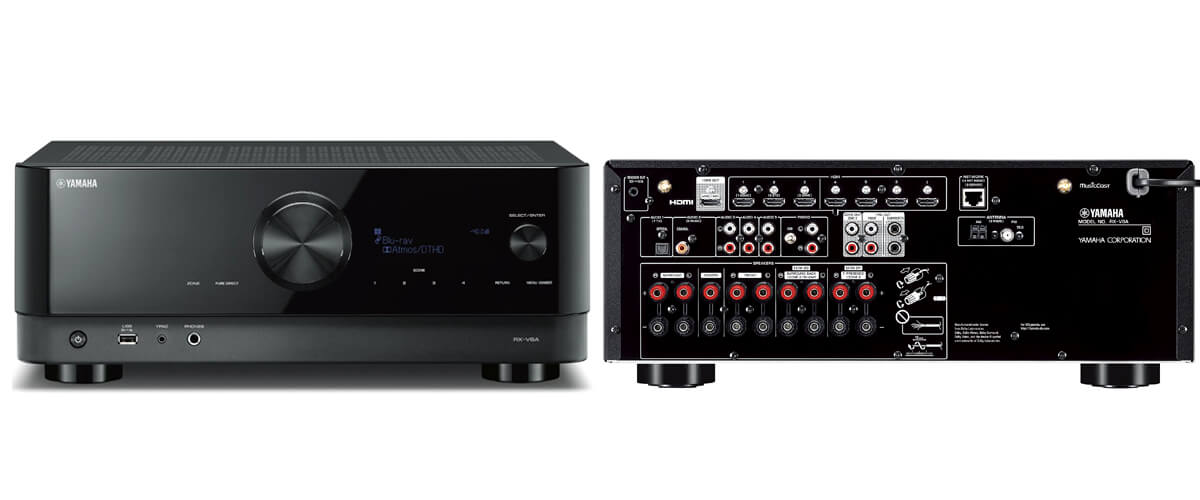
Of course, I would have liked to add a few more quite popular models to my review, but according to the test results, they turned out to be a bit weaker than the devices presented in this article. One of them was the Yamaha RX-V6A. This Atmos receiver under 1000 dollars has many advantages: 7 in/1 out HDMI (with support for 4K/8K, HDCP 2.3, and eARC), MusicCast App control, and good power and networking capabilities. That’s why this AVR has found a lot of fans all over the world.
By the way, I really liked the automatic and manual customization of the web interface. In this respect, I had no complaints. The sound was very detailed, built the scene well, and the power was enough. The device reads many audio formats from a flash drive, including DSD. Excellent switching of all the equipment. However, it has some disadvantages that I want to tell you about.
And first of all, it is the interface, which sometimes takes a very long time to “think”. This is not a critical problem, but it can be annoying. I also want to note a very small step of volume control when controlling with the remote control. The screen on the front panel is a bit small (this is noted not only by me but also by many users). It clearly lacks convenience and informativeness.
Also, the RX-V6A is not compatible with Samsung’s new flagship TVs. It’s hard to say what the problem is, but this greatly reduces the possibilities of using smart TVs. HDMI ports, although 2.1 version, have a bandwidth of only 24 Gbit (the standard itself allows up to 48 Gbit), which introduces compression at high resolutions.
On a combination of pros and cons, this 8k AV receiver didn’t make it into my selection. That’s not to say it’s bad. It has a lot of advantages, but I found options with fewer disadvantages than the RX-V6A and that are more optimized in terms of price/performance ratio.

